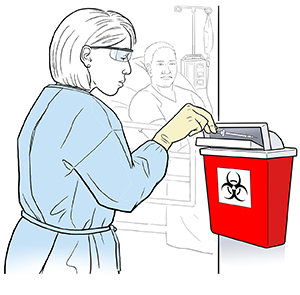Standard Precautions: Needles and Other Sharps
Used needles, lancets, blades, razors, and other sharp devices (known as sharps) can cut or prick you. This can expose you to bloodborne germs. Take time to handle sharps safely.
Handling sharps safely
Always move carefully while handling sharps. To prevent exposure to blood and OPIM (other potentially infectious materials):
-
Never throw a sharp into the trash. And don’t put a used sharp down. Dispose of it in a marked sharps container as soon as you’re done with it.
-
Don’t bend, break, or recap needles. Never remove used needles from disposable syringes.
-
Get help before using sharps around patients who are confused or uncooperative.
-
Make sure used sharps don’t get left in linens or on bedside tables.
-
Never clean up broken glass by hand.
-
Use needle-less connector systems whenever possible for administering IV fluids.
Using sharps containers
Containers for the disposal of sharps will be provided by your facility. These containers must be puncture-proof and leakproof. They must be clearly marked with a biohazard label. Follow these tips for safe use of sharps containers:
-
Never overfill a sharps container. Dispose of sharps containers according to your facility’s guidelines when they’re 2/3 full.
-
Never force a sharp into a sharps container. Be careful, and watch as you place sharps into the container.
-
Never reach into a sharps container.
-
Never open, empty, or reuse a sharps container.
 |
| Immediately after use, dispose of sharps in a marked sharps container. |
Exposure guidelines
Even when using standard precautions, you may be exposed to bloodborne pathogens on the job. Know the guidelines stated in your facility’s exposure control plan. These guidelines must be followed in cases of sharps exposures, splashes or sprays of blood or OPIM, or other exposures. If you have a sharps exposure:
-
Wash the area well with soap and water for 15 minutes. If your eyes are exposed, rinse them well with water only (don’t use soap) for 15 minutes.
-
Get medical attention right away. Time can be crucial in preventing infection. Your blood may need to be tested for HBV, HCV, and HIV. You may also receive vaccinations or post-exposure treatment to reduce your chances of becoming infected.
-
Don’t try to evaluate your own exposure.
-
Report the exposure to your supervisor or other facility personnel. The patient whose blood or OPIM you were exposed to (if this is known) can be tested for a bloodborne infection. This helps determine whether you are at risk.
-
Adhere to follow-up testing, as indicated.
© 2000-2024 The StayWell Company, LLC. All rights reserved. This information is not intended as a substitute for professional medical care. Always follow your healthcare professional's instructions.